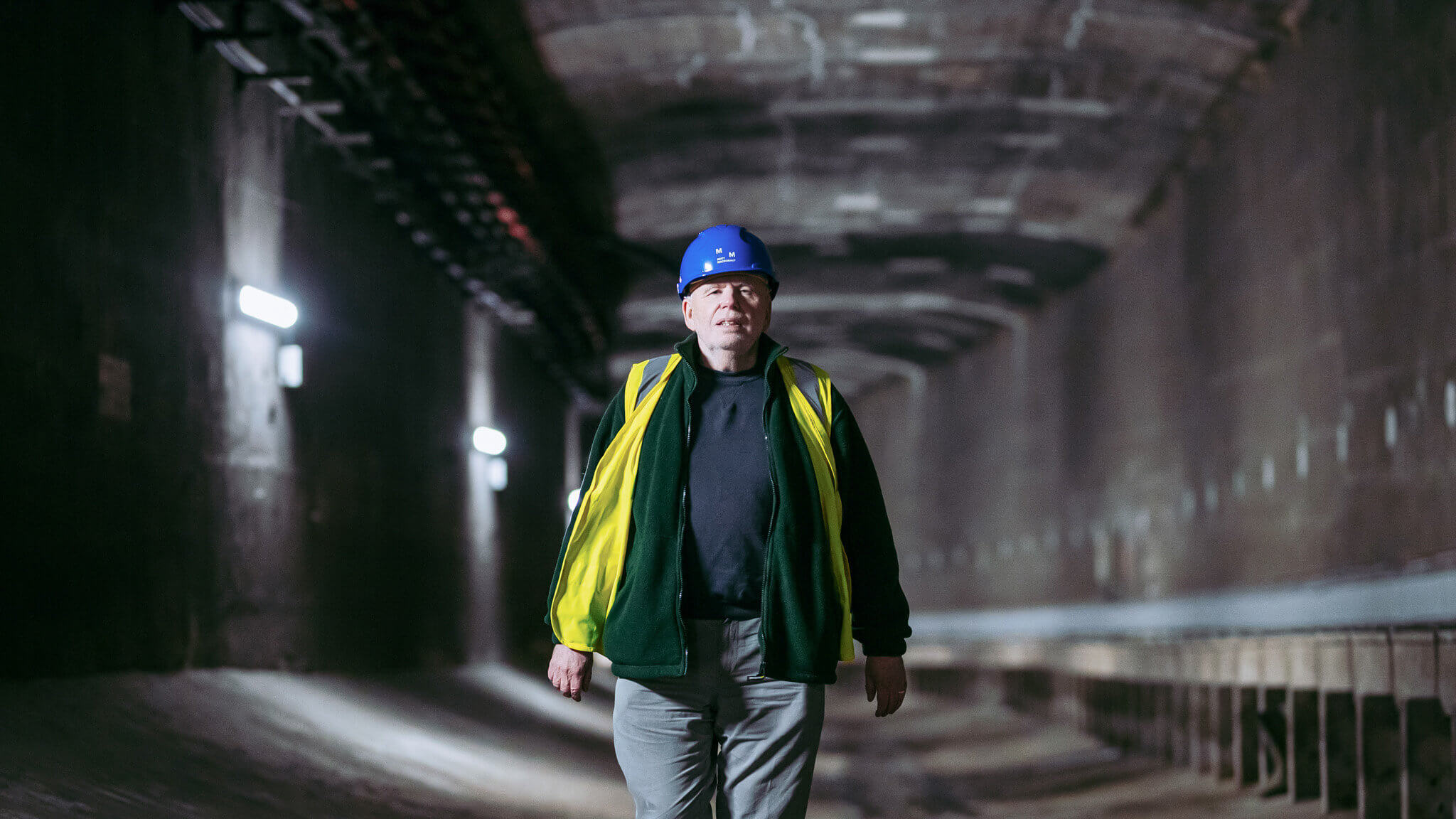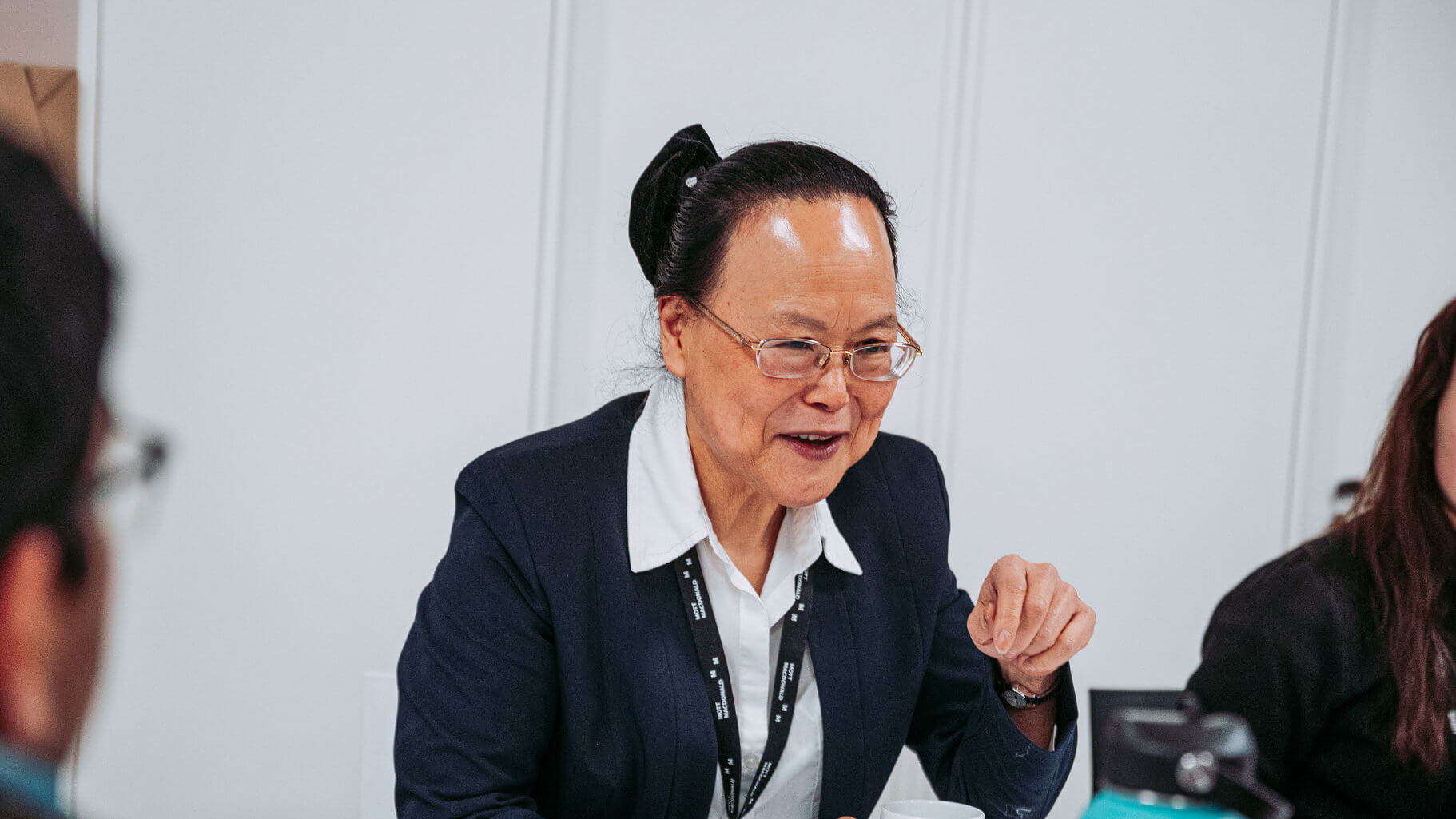Standard-bearers for technical excellence
Our fellows
Bold minds, industry leaders, inspirational mentors, tireless pioneers: In 2023 Mott MacDonald named Paul Lambert, Sun Yan Evans and Tony O’Brien as its first three Fellows in recognition of their outstanding life-long records of achievement.
Paul, Sun Yan and Tony are all preeminent technical experts, recognised internationally for shaping the fields in which they work, providing new insight and understanding, adding to industry knowledge and pushing standards and practices ever higher.
Paul Lambert is a chartered materials engineer and chartered scientist with more than 40 years’ experience in understanding, improving and sustaining the fabric of the world around us. He is head of materials and corrosion technology, a practice that he helped develop when he joined Mott MacDonald in 1989 to provide materials solutions for the Channel Tunnel between England and France.
Sun Yan Evans is a chartered civil engineer with four decades of expertise in the water sector, and a lifetime’s fascination with the power of water. She is a technical director at Mott MacDonald, focused on water resource management, resilience and water quality. She has spearheaded the creation of Mott MacDonald’s hydrodynamic computer modelling capability that now numbers more than 100 people.
Tony O’Brien is a chartered civil engineer and specialist in geotechnical and foundation engineering. He has spent more than 40 years improving engineers’ understanding of the ground beneath our feet. He is the global leader for Mott MacDonald’s geotechnics practice, a 500-strong international team of professionals that he has helped build.
Our Fellows are standard bearers for the technical excellence that is so important to the future success of Mott MacDonald.James Harris
Executive chair, Mott MacDonald
Together, they have spent a combined 120 years in industry. They have authored 260 papers and articles, written eight books, trained more than 800 people and influenced countless more. They all devote time to teaching, mentoring and enthusing future generations in schools, at universities and at industry events.
The careers of all three are characterised by ceaseless curiosity, passion, innovation and collaboration. They continue to play key roles in solving our clients’ toughest challenges and encourage colleagues to stretch towards new horizons.

Paul Lambert
Head of materials and corrosion technology, Mott MacDonald / BSc PhD CEng CSci FIMMM FICorr
“Getting the most out of materials is more important now than it’s ever been,” Paul says. “Preserving materials saves money, saves energy, saves carbon – it’s the sustainable thing to do.”
Paul is a Fellow of the Institute of Materials, Minerals and Mining, a Fellow of the Institute of Corrosion, and an Industrial Fellow of the Royal Society. He is a past president of the Institute of Corrosion. He conducts research into novel materials, protective coatings and repair technologies at Sheffield Hallam University, where he has been a visiting professor for more than 20 years.
Paul’s career has included devising simple-to-apply waterproofing systems for buildings in South Africa, training bridge inspectors in Qatar, developing corrosion prevention systems for a 9/11 memorial in the US, and designing protective coatings that could be applied to locally-sourced materials for a World Bank-funded modern sewerage system in Iran. Such is his reputation that he has been called on as an expert witness on corrosion in court cases around the world.
Paul is best known as one of the world’s leading authorities in applying cathodic protection to reinforced concrete and iron- and steel-framed structures. This technology is predominantly used to halt corrosion, so maintaining the structural strength and integrity of buildings and infrastructure. Paul’s work has resulted in cost-effective long-term life extensions for bridges, tunnels, multi-storey carparks, historic buildings and even works of art.
Paul, Sun Yan and Tony stand out not just for their technical expertise, but also their ability to excite and motivate our people to achieve a higher standard of technical excellence. They’re pioneers who continue pushing the boundaries in terms of technical excellence and innovation.Cathy Travers
Group managing director, Mott MacDonald
At the Silver Jubilee Bridge near Liverpool UK, for example, Paul designed cathodic protection for the bridge’s supporting piers which, over the decades since being constructed, had required significant concrete repairs every three to five years. In the 30 years since the system was installed, those piers have needed no further repairs.
“The industry had been approaching concrete repairs like early toothcare – see a hole and fill it,” says Paul. “We’ve come a long way since then.”
As well as cutting repair and maintenance, preserving structural performance and extending the working life of protected structures, Paul’s work to control corrosion reduces disruption to those who use them. It also saves materials, energy and cost, benefiting the planet as well as his clients’ bank balances.
“Paul’s expertise is incredibly rare,” says James Harris, Mott MacDonald’s executive chair. “His depth of knowledge and expertise, and his willingness to just help colleagues, has been fantastic. There are many people in the business with a story about Paul’s expertise, his responsiveness, and his desire to help.”
After spending decades shining a spotlight on the importance of materials science in major civil engineering projects, Paul is leading the charge towards integrating his team’s specialism right from the beginning of new infrastructure developments. “Using materials correctly from the start means they will last longer, and that is more cost-effective and more sustainable,” he says.
Paul is also working to make major new infrastructure “CP-ready” – that is, designed in such a way that cathodic protection can be more easily retrofitted in the future to extend lifespan. Examples include tunnels, bridges, pipelines and other critical infrastructure.
“There is an awful lot of infrastructure out there that CP can add value to,” says Paul. “Anything constructed using iron or steel. In the end, making things last is what my career has been all about, and all I’ve really wanted to do. Over time that has become more important for clients and society – something that’s of value for everybody else. I’ve been very fortunate in that respect.”

Sun Yan Evans
Technical director, water, Mott MacDonald / BSc MSc CEng FICE CIWEM
“Everywhere, life needs water,” Sun Yan says. “Water is an incredible resource, but too much, too little, or poor quality water can be damaging.”
Sun Yan is a Fellow of the Institution of Civil Engineers (ICE) and a member of the Chartered Institution of Water & Environmental Management. She is also a member of the Defra, Environment Agency, and Natural Resources Wales research and development advisory group, informing UK government policy, strategy and standards.
Sun Yan’s career began in China in the early 1980s with research into water quality, which remains central to the country’s national standards today. Since then, she has worked across the world on some of the most forward-thinking projects involving water quality, flood resilience and water modelling.
In Chad and Cameroon, Sun Yan helped develop better understanding in improving biodiversity along the Waza Lagone river system and its floodplain, a project that called for a large-scale hydraulic model along more than 300km of the river.
In the UK, Sun Yan was the driving force behind a flood resilience programme designed to safeguard more than 100 sites for National Grid; the Boston Barrier flood defence system, a £100M project that protects more than 14,000 homes; and the Humber Hull Frontage flood defence improvements, which reduces flood risk for 113,000 properties.
Sun Yan has been called on as an expert witness in public inquiries and court cases. She is a prolific author, with several books, contributions to the Institution of Civil Engineers’ State of the Nation reports and more than 30 papers to her name. She has received more than 20 industry awards in the past two decades.
Technical excellence in Mott MacDonald is delivered by our global network of practice leaders and technical excellence leaders. Paul, Sun Yan and Tony are preeminent within that network.Stephen Flanagan
Group head of excellence, Mott MacDonald
Among Sun Yan’s landmark achievements, she developed a methodology to assess flood risk and the potential impact of overtopping for reservoirs. Her work addressed the urgent need to assess more than 2000 reservoirs when available funding would have allowed for assessment of only 100 using conventional methods. Throughout the 1980s Sun Yan pioneered the use of computer modelling to address engineering challenges more efficiently. In this instance, her use of data, automation and interpolation, linked with a graphic user interface to aid communication, enabled all the reservoirs to be assessed within the available budget. Her system has been continually refined and is used by the Environment Agency nationally.
“Engineering is, in many senses, about turning the seemingly impossible into the possible,” she says.
Sun Yan has led the development of similar smart solutions for assessing the risk and impacts of coastal and river flood defences being overtopped, with the insights informing disaster response planning, public communication and investment in defence strengthening.
“Not only does Sun Yan strive for the highest levels of technical excellence, she’s working hard to pass that knowledge on to the next generation,” says James Harris, chair of Mott MacDonald’s executive board. “That’s leadership at its best.”
Sun Yan is also passionate about education outreach initiatives designed to help young people see the value in a career in engineering.
“Water engineering touches so many areas of life – our health, food production, flood protection and diverse ecosystems, and it interacts with transport, buildings and energy systems. As a water engineer you can travel the world, meet great people and do a lot of problem solving. It’s an enormously fulfilling career. I just love it.”

Tony O’Brien
Global practice leader for geotechnics, Mott MacDonald / BSc MSc CEng DIC FReng
“Geotechnical engineering is art and science,” says Tony. “It isn’t magic, but the benefits we can deliver in budget, schedule and environmental and community impact can make it seem like it is.”
Tony is a Fellow of the Royal Academy of Engineering and a Fellow of the Institution of Civil Engineers. He contributes to numerous technical committees worldwide.
Tony is a leading light in employing the observational method (OM), a process which adapts the construction of foundations, deep excavations or tunnels according to modelling and analysis of data from continuous measurement of ground movement. OM enables project teams to tailor ground support to actual conditions, often resulting in significant savings in materials, time, and cost, as well as improved safety for workers.
One of Tony’s most high-profile application the OM was during construction of the new Wembley Stadium in north London. The stadium’s famous 1700t, 330m tall, 315m span steel arch was assembled on the ground and then had to be lifted into position. This was done by creating a rotating connection between the ends of the arch and its foundations. The crown of the arch was then hauled up to its final position 22° off vertical. The six week lift placed huge temporary sideways forces on the foundations. To protect against potential movement, the foundations would ordinarily have been substantially ‘over-designed’ to compensate for horizontal loading. However, Tony and team used the OM to monitor the foundations. The team had designed extra support in case needed, but monitoring showed that the foundations resisted movement without, and the lift was completed avoiding the additional complexity and cost.
Tony’s expertise has taken him all over the world to work on the most complex geotechnical challenges. One such was creation of 7000ha of reclaimed land for the third runway at Hong Kong International Airport. Dredged material had to be built up on the extremely soft clay seabed. Conventionally thousands of piles would be installed to bear the weight of the reclaimed land – at huge cost and causing extensive water pollution in the process. Tony and Mott MacDonald colleagues solved the problem by mixing cement deep into the clay, effectively transforming it into concrete. It was the region’s first application of deep soil mixing, changing perceptions internationally of how soft marine clays can be engineered.
Climate change has been of major interest in the last 20 years. His research into how climate change affects soil, in conjunction with Cambridge University and Southampton University, has been written into the guidance that governs all railways and highways infrastructure across the UK.
“Tony is preeminent in his field,” says James Harris, chair of Mott MacDonald’s executive board. “His work on understanding the impact of climate change on earthworks movement is hugely significant and has been baked into best practice across the UK and internationally.”
Sharing what he’s learned with others is important to Tony. He has written four technical books and more than 50 papers on ground engineering, contamination and earthquake resilience. He is lead author for the section on foundation design in the ICE Manual of Geotechnical Engineering. And he is a visiting professor at the Universities of Southampton University and Imperial College London.
Tony encourages young engineers to use their imaginations to seek better solutions. “More people need to challenge the status quo. If we’re going to do anything meaningful in terms of sustainability, we cannot keep doing what we’re doing,” he says. “We need to get out of our comfort zones. We learn more about ourselves and create better solutions in the process.”
Tony is taking his own advice by becoming an early adopter of technologies that use artificial intelligence. He says: “We’re creating data mountains but we can’t analyse it all – we need machine learning to help us extract value in a better timeframe.”
Technical excellence in Mott MacDonald is delivered by our global network of practice leaders and technical excellence leaders. Paul, Sun Yan and Tony are preeminent within that network.Al-Mansoor Amin Principal dry utilities engineer



